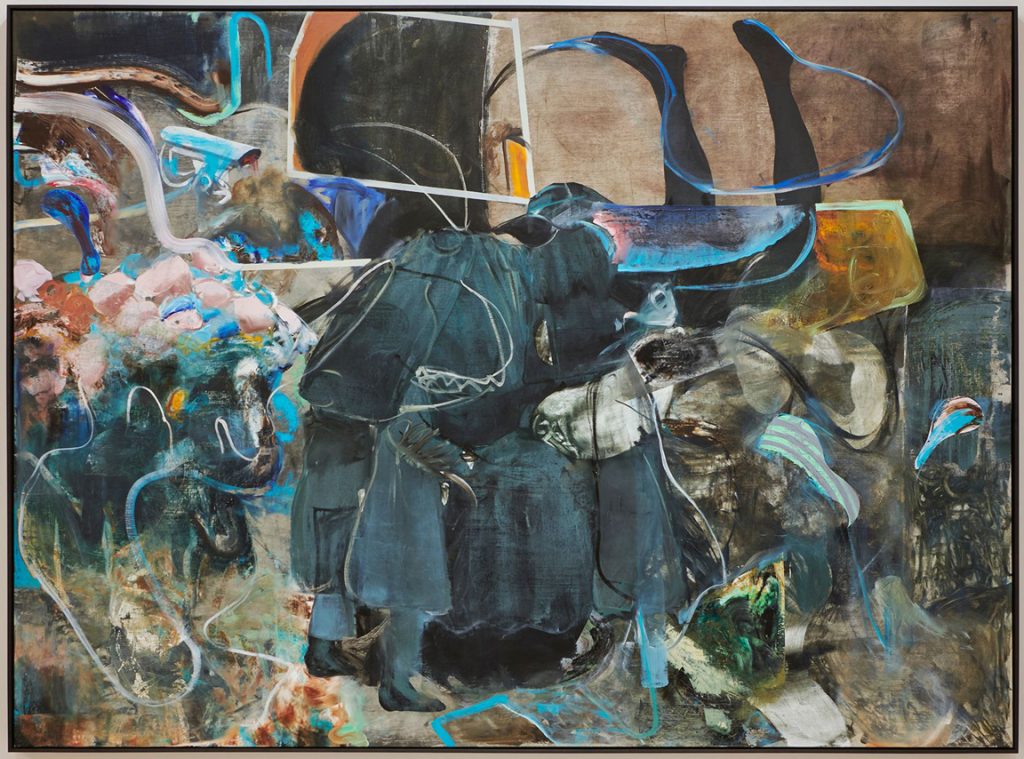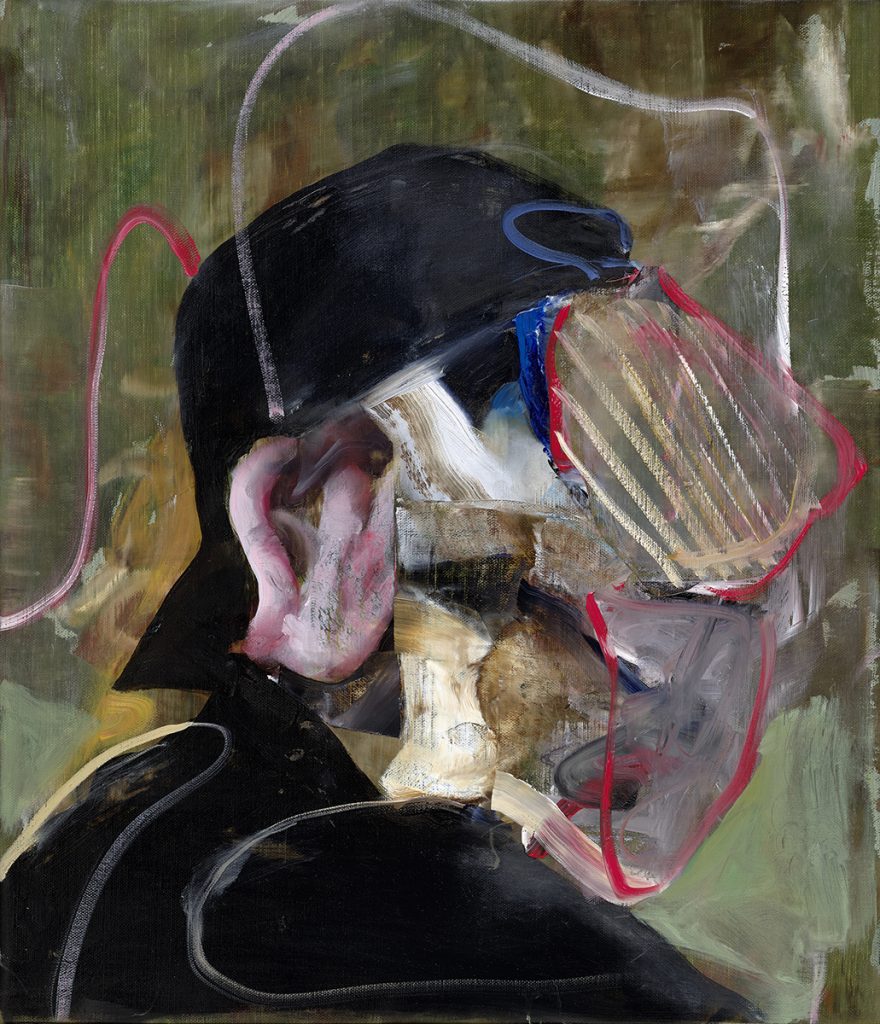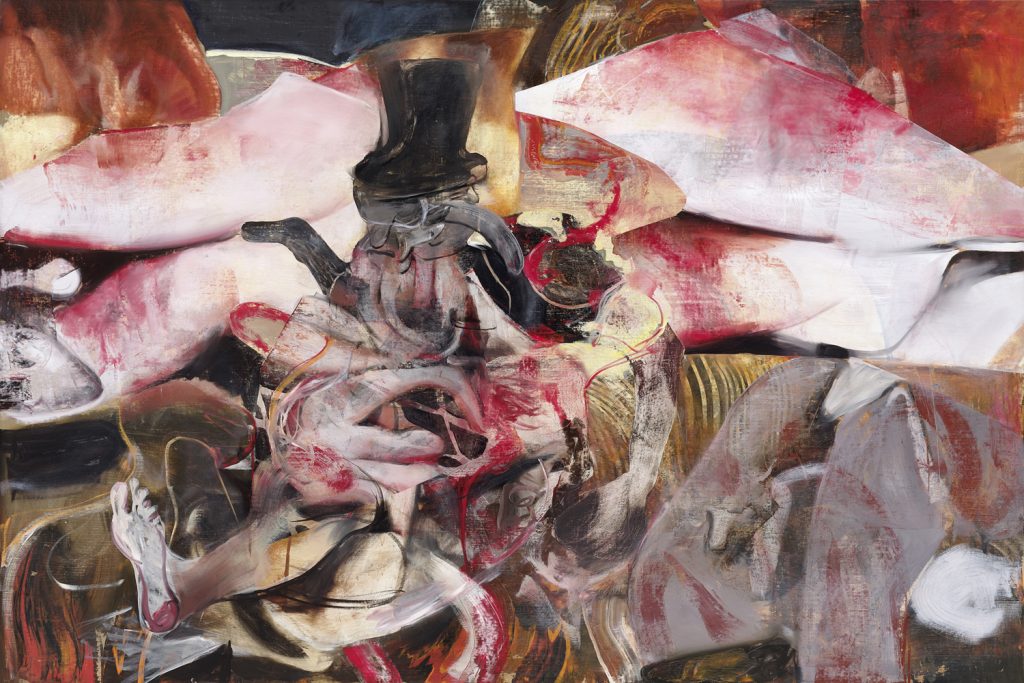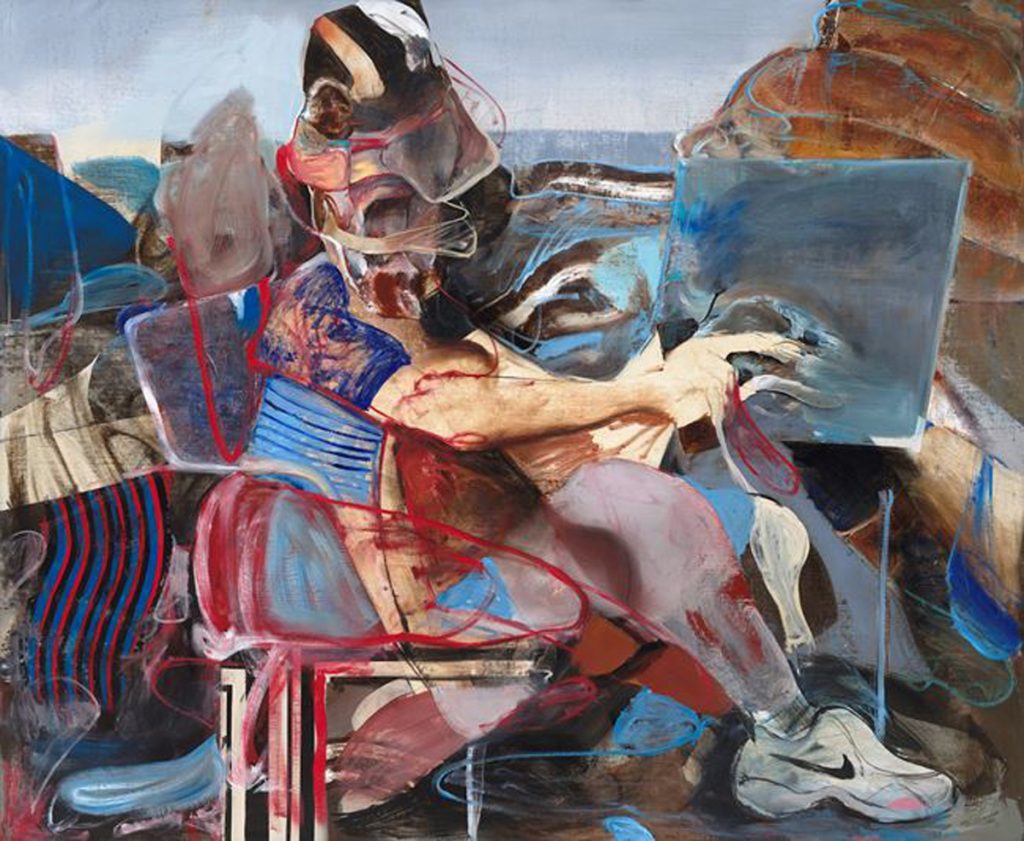by Mary Hrbacek

Pace presents “Adrian Ghenie: The Hooligans,” an exhibition of nine large-scale semi-abstract oil paintings and three charcoal drawings rendered on paper. The term “hooligans” refers to an underground group of individuals who ignore the limitations of polite society, shaping their lives to be free of constraints. In his powerful new works, Ghenie explores the artists who formed movements that rocked established academies, challenging the status quo of their times with new visions of transformed realities, reinvigorating art in the process.
Ghenie has identified J.M.W. Turner, the Impressionists, especially Claude Monet, Vincent Van Gogh and Paul Gauguin as the artist “hooligans” whose activities he chooses to emulate. His focus is on the primacy of oil paint in a semi-abstract approach which downplays figurative imagery. This daring exhibition is beautifully installed, presenting bold monumental paintings and intriguing charcoal drawings, but it is unfortunate that it is located on the second floor, where it is possible that the public may overlook it.

Adrian Ghenie was born in 1977 in Baia Mare, Romania; he now lives in London, Berlin and in Cluj-Napoca, Romania. Ghenie studied art history and mastered the formal techniques of European painting. In his new works the artist incorporates concepts from the Dada movement, along with the semi-recognizable figures of Turner, Van Gogh, and Gauguin in mysterious absorbing formats.
Ghenie’s eloquent paintings require viewer concentration and engagement; they are not prefabricated or manufactured. He doesn’t even use brushes to apply the paint. He creates the works by scraping paint strokes with palette knives and stencils; this technique produces emotionally charged picture surfaces. He pushes the limits of the painting genre further by using suggestive loosely defined non-descriptive shapes in complex configurations that assert the immense power of his works. Ghenie’s networks of deep layered and redrawn shapes, photos from magazines and mysterious roaming lines provide the viewer a fresh experience, not easily described, with a mournful edge which alludes to the strange times in which we live.

The intriguing work “Mr. Turner” (2020) appears to display at least the edge of one of Dante’s circles of hell as described in “The Inferno.” Ghenie often mingles confounding, tangled layers of dream-like shapes, that he fragments into myriads of heaped interlocking forms, whose harmonious colors integrate the disparate surface formats. He applies the paint as if a strong wind has blown it through the four corners of the picture, covering each section in varied thickness and transparency, in an absorbing round of texture and opacity. The red hues whose underpinnings dominate the piece with tattered body parts may reference the Covid 19 pandemic. Today, the sight of ambulances adds a macabre aspect to everyday life, sending a somber message that the picture echoes. The work furnishes an encounter that reaches well beyond the visual, to a deep place inside which responds to the primordial processes enmeshed in the canvass, projecting the viewer forward into the unknown.

Ghenie’s “Self-Portrait ‘en plein air’” (2020) presents an ironic take on the concept of “plein air” that displays an unrecognizable artist apparently experiencing the agony which often accompanies creative outdoor pursuits. The artist in the picture employs muted modulated colors accentuating the serious tone of his efforts while he scrambles to keep his tools and materials organized. As he experiences the pain of his isolation and the hardship of his existence, Ghenie seems especially to identify with the enduring creative spirit of the solitary Van Gogh. Van Gogh occupies an unusual position in the body of works on view. He is seen as a figure of suffering and redemption who sacrificed his health and eventually his life to his work, which by its intrinsic character revitalized painting. In “On the Road to Tarascon 4,” 2020, Ghenie pays homage to the artist in a re-created image of Van Gogh who is seen in transit, moving as if the portable easel were a part of his anatomy, on his way to paint outdoors in the open air.
British painter Francis Bacon’s dark iconic works have been a major influence in contemporary art; he seems to have inspired some of Ghenie’s enigmatic disturbing visions. Bacon himself owes a debt to Abstract Expressionist Wilhelm De Kooning, whose conflated brush strokes spurred Bacon’s visceral interpretations. “The Impressionists” presents a grim kneeling black-robed figure in an unexpected example of an elusive work that expresses the antithesis of the ethereal light-drenched works of Impressionism; Ghenie’s palette is comprised of subdued mixed hues that recall dim Eastern European light. “The Haystack” is another unfathomable large-scale work that defies immediate interpretation.
Ghenie’s engaging charcoal on paper portrait drawings employ the medium in techniques that mirror his oil on canvas portraits. The drawings are somber, visceral evocations of masters who have experienced hardships in their efforts to bring their art to fruition. In Ghenie’s portraits, Turner, the artist himself, and Gauguin are constructed with truncated body parts in which the condensed power of their creativity seems to have reached its peak. Nothing about the images is contemplative; the urgency of their intentions seems to have spurred them to epic personal transformations and subsequent achievements. The artist reverses traditional portraiture by displaying images that reveal the dark depths of his subjects’ psyches rather than pleasant looking facial features.
Ghenie is influenced by Charles Darwin’s text “On the Origin of the Species” (late 1850’s), with its emphasis on the survival of the fittest. It seems that a similar dictate applies to the field of painting; if it is not periodically reinvigorated, its meaning and relevance will fade from our culture. Ghenie believes that painting is now in a cyclical crisis that repeats itself historically, as demonstrated by the oeuvres of the Impressionists, Turner, Van Gogh and Gauguin, artists whose works he explores in this show. Recycling adds a new spin by extending art and regenerating the media. Turner dissolved a train into a cloud of mist in a convincing painted atmosphere. Picasso and George Braque revamped Cezanne’s geometric brushstrokes to forge the Cubist movement, which contributed to the founding of abstract art. The Impressionists, through their reductive multitude strokes of luminous light foresaw the onset of the Atomic Age.
It is rare to find an international art star who cares profoundly about the progression of art, who seems to love the act of painting enough to make pictures whose sole subjects are the painters who have contributed to its evolution. It is prescient that Pace has brought Ghenie’s works to share with worldly New York audiences, who have experienced the development of contemporary art first-hand. Whether one appreciates it or not, this heroic exhibition offers an example of works that probe the ominous side of progress to help unfold a struggle that challenges the omniscience of technology.
